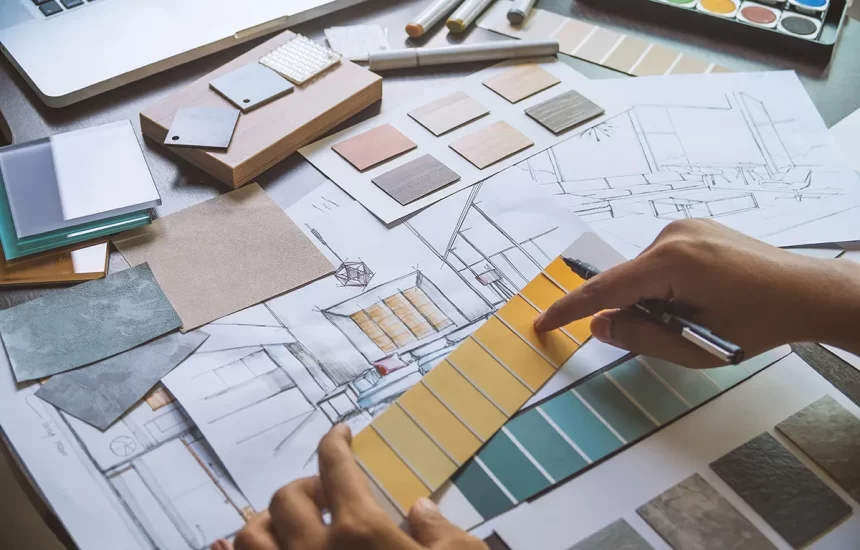Have you ever stepped into a room and immediately felt a sense of calm, joy, or energy? That’s the magic of a great interior designer. It’s more than just arranging furniture and picking colors—it’s about creating spaces that truly resonate with the people who use them. Whether it’s a cozy living room that reflects your personal taste or a commercial office that inspires creativity, interior design has the power to shape how we feel, work, and live.
But what exactly does an interior designer do? And why should you hire one to transform your space? Let’s dive into the world of interior design and explore how it can make a world of difference in your life.
What Does an Interior Designer Do?
An interior designer is a professional who plans and decorates the interior of a building to create aesthetically pleasing and functional environments. Unlike an interior decorator, who focuses mainly on the visual aspects, an interior designer considers the architectural layout, spatial flow, lighting, color schemes, and the purpose of the space. They blend creativity with practicality, designing spaces that are both beautiful and functional.
Interior designers work with clients to understand their vision and needs, whether it’s a single room or an entire home or office. They develop design concepts, create mood boards, and source furniture, materials, and decor to bring the vision to life. They also coordinate with contractors, oversee project timelines, and manage budgets to ensure that the design process runs smoothly.
The Process: From Dream to Reality
The process of working with an interior designer is a collaborative journey. It begins with a consultation, where the designer gets to know you and your space. During this meeting, they’ll discuss your preferences, lifestyle, and goals for the space. Do you want a home that feels calm and cozy or one that’s vibrant and energizing? Are you designing a functional workspace that encourages productivity, or a home that’s a haven of relaxation?
Once the designer understands your vision, they’ll develop a design concept that includes a color palette, layout, furniture, and other design elements. Depending on your project, they might create detailed floor plans, 3D renderings, or mood boards to help you visualize the final look.
After you approve the design, the designer takes charge of the project, coordinating the selection and procurement of furniture, textiles, lighting, and accessories. They may also work with contractors to handle structural or renovation work. The designer is your guide throughout the entire process, ensuring that everything comes together on time, on budget, and to your satisfaction.
The Magic of Personalization
One of the most exciting aspects of working with an interior designer is the opportunity for personalization. Your space should reflect who you are—your personality, style, and values. Whether you love sleek, modern lines, the warmth of rustic wood, or a bold, eclectic mix of patterns and colors, an interior designer will help you create a space that speaks to you.
Interior designers take the time to understand your lifestyle and preferences. Do you entertain often and need an open, inviting space for guests? Or do you value quiet and relaxation, needing a serene bedroom retreat? By understanding your needs, an interior designer can tailor the design to make your space not only beautiful but also functional and suited to your everyday life.
Why You Should Hire an Interior Designer
While some people may be tempted to tackle interior design projects on their own, there are several reasons why working with a professional designer is worth the investment. Here’s why hiring an interior designer could be one of the best decisions you make:
- Expert Knowledge and Skills: Interior designers are experts in their field. They know the latest trends, design principles, and how to balance style and function. They can make your vision come to life while ensuring that the space is cohesive and well-designed.
- Saves Time and Reduces Stress: Designing a space takes time, effort, and coordination. An interior designer takes care of all the details, from sourcing furniture to managing the installation process. This saves you time and eliminates the stress of figuring out what works and what doesn’t.
- Access to Resources and Vendors: Interior designers often have access to exclusive furniture, fabrics, and decor that you may not find in stores. They also have trusted relationships with contractors, artisans, and vendors, which can help ensure you get high-quality pieces at competitive prices.
- Budget Management: Many people think interior designers are out of their price range, but a good designer can work with your budget and make it stretch further. They can help you prioritize spending, find cost-effective solutions, and avoid costly mistakes.
- Enhanced Functionality: A designer isn’t just concerned with aesthetics—they’re also focused on making the space work better for you. Whether it’s improving the layout of a small apartment or designing a spacious kitchen that makes cooking easier, interior designers know how to maximize both style and functionality.
- Timeless Appeal: An interior designer can help you create a space that looks timeless, ensuring that it remains stylish and functional for years to come. They can blend classic elements with modern trends in a way that won’t quickly go out of style.
The Impact of Interior Design on Well-Being
Did you know that your environment has a direct impact on your mood and well-being? A well-designed space can uplift your spirit, inspire creativity, and promote relaxation. The colors, textures, and furniture in your space can influence how you feel and how productive you are. For example, a cluttered room can feel stressful, while an organized, calming space can help you unwind after a long day.
Interior designers understand the psychological effects of design elements and use that knowledge to create environments that support their well-being. From optimizing natural light to choosing colors that evoke specific emotions, interior designers can create spaces that make you feel your best.
Conclusion
Interior design is an art form that blends creativity, functionality, and psychology to create spaces that are both beautiful and practical. An interior designer takes your vision and transforms it into reality, making your home or office a reflection of your personality, lifestyle, and goals. Whether you’re redesigning a single room or renovating an entire space, hiring an interior designer ensures that the process is seamless, stress-free, and, most importantly, tailored to your unique needs.
So, if you’re looking to elevate your space, create a more functional environment, or simply make your home feel like a true reflection of yourself, consider working with an interior designer. With their expertise and creativity, your dream space is within reach.






